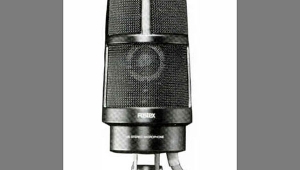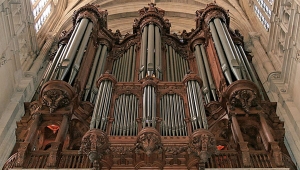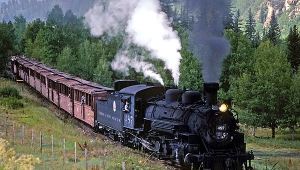| Columns Retired Columns & Blogs |
Workin' on the Railroad Page 2
Mobile Fidelity's president and founder, Brad Miller, got hooked on trains as a kid, and when his father bought one of the first home tape recorders, Brad started borrowing it. He soon became hooked on recording too, switching first to stereo, then to 4-channel sound as each offered an improvement in his ability to record trains the way they actually sound. Offering some of his recordings for public sale just seemed the next logical thing to do, and it subsidized his hobby. (He also organized a Muzak-style orchestra called "Mystic Moods," and issued some recordings in which he mixed music with mood-setting background sounds. Buyers hated them, writing to complain bitterly about the sounds messing up the music or the music messing up the sounds, depending on what they wanted to hear.)
Footnote 2: This refers to the wheel configuration: 2 small front guide wheels (1 per side), 6 large drive wheels, 2 rear guide wheels.
MFPN's crew for this mid-September "shoot" included Brad M, Mrs. Miller (also known as Patricia), and train buff and frequent recording partner Joe Niklas and his wife, Sarah. Brad had invited me to join them, to find out what MFPN was all about and, maybe, get a little free publicity. The two teams had spent several preliminary days scouting the route for trackside locations where all the desired elements of terrain, track grade (steepness), and access to a suitable recording site were optimal. After selecting what appeared to be the best ones, it was necessary to obtain access permission from whoever owned the tracts of land where the recordings would be made from, as well as from the operators of the train itself. The latter was necessary because the object of these sessions was to record whistle sounds, and in order to get them phrased in the right manner, at the best times to take advantage of the terrain echoes, Brad himself wanted to be at the whistle cord, for which it was necessary for him to ride in the cab of the locomotive.
The day I was to accompany the teams was their second day of actual recording. On the first, Brad had one of the recording systems right in a locomotive cab, where the sound of the whistle was, as he described it, "earsplitting." Unlike most steam locomotives, which had the whistle located at the front of the engine, this one—a Baldwin 2-6-2 (footnote 2) "Mikado"—had it mounted right on top of the cab. (The engineers who routinely drive the train all wear earplugs. Brad hadn't thought to bring any.) On the day of my visit, all recordings were to be made from trackside.
Each team had its own car, each loaded with identical recording systems consisting of a new kind of 4-channel digital processor, a Sony Model VO-6800 portable (18-lb) U-MATIC VCR, several 25-foot lengths of mike cable (each carrying all four audio channels), a lightweight microphone stand, two belt-strap battery packs, a pair of wide-range AKG headphones, a few blank videocassettes, and a custom-built coincident 4-channel condensor microphone mounted inside a large windscreen that looked like an obese blue-gray phallus. The total weight of one such complete "mobile" recording system is around 55lbs.
Since the train wasn't scheduled to depart the Chama station until 10:30 AM, I wondered why we had to set out for the first recording site at 9. I found out soon enough. We followed paved roads for about 15 minutes, then followed a dirt track for about half a mile to a small group of tourist cabins in the middle of the large tract of land at whose edge we would be setting up. The dirt track ended at the cabins; the rest of the way we would go on foot.
I stood by idly while both recording systems were unloaded and hung from shoulders and hands, until I finally succumbed to an attack of guilt. "Here, let me carry something," I said. Brad handed me a battery pack that must have weighed all of 5lbs.
The trek to the first site was a snap: across a wide field to the far fence, and through a gate to the train track. We followed the track for about a half a mile, to a grassy knoll overlooking a distant highway. There we pause while Brad, barking instructions like a Prussian general, outlined the next step. He and the ladies would set up at a site near there, and one of them would drive him back to Chama to board the engine. Joe was to continue on to a site nearer to the tracks.
I dumped my battery pack, and set out with Joe because I had gotten the impression that what he would be taping offered better prospects for interesting photographs to go with the article I hoped to get out of all this. Once again, I volunteered to carry something. "What about the VCR?" I offered, expansively. He handed it to me without hesitation. It had a wide, comfortable shoulder strap, and again the walk was easy: all downhill.
Our setup location was next to a track curve about a hundred yards from a wooden trestle bridge (footnote 3) spanning a deep, narrow gully. There would be some action here, Joe told me, because the train would have to do some engine shuffling. Because most of the run from Chama to the Cumbres station is up a steep (4%) grade, the train would pass here with two locomotives in tandem pulling it. Because, however, of the load-bearing limitation of the trestle, only one locomotive at a time could cross it. The first would uncouple from the second, cross the trestle by itself, then stop and wait for the second to cross with the rest of the train. (Fortunately, the track grade was not steep at that point). They would then recouple, and start up the increasingly steep stretch of track next to where we would be setting up. Joe began unloading his gear while I scouted for some good places from which to photograph.
It was obvious from the start that wind was going to be a problem. The four-channel microphone would best capture the whole ambient field if it was at least several feet above the ground (where its rear quadrants would not be aiming at a nearby embankment) and well away from any other sound-absorbing barriers such as dense shrubbery. There was, however, enough of a breeze that, despite the windscreen over the mike, air turbulence would have caused pops in the sound. That, Joe explained, meant two things: seek a wind barrier of some kind, and get the mike near the ground.
As a barrier, he selected a meager shrub about 15 feet from the track. He placed the unfolded mike stand on its side, anchored it in place with some small rocks, and attached the mike, vertically, on the leeward side of the shrub. The capsules were about 10" above the ground, but I noticed, to my surprise, that when the upper part of the shrub was swaying in the breeze, the leaves down near the capsules were motionless. The wind problem was apparently solved.
Then I got my first glimpse of Colossus. Unlike the kludged prototype I had been expecting, the digital processor looked like a finished product, with a flat-white front panel with silk-screened black lettering, and a pale blue perforated metal top. It had four gain controls on the front, and I noticed that Joe had turned them all the way up. "You mean," I asked incredulously, "you're actually going to try recording a train from 15 feet with everything wide open?" Joe explained, patiently, that Colossus and the microphone had a dynamic range greater than that of human hearing, and were calibrated together so that it was almost impossible to overload them. And there were VU indicators on the front panel to show when they did need to be turned down. I later learned that the mike overloads at an SPL of 140dB, but Colossus doesn't. Thus, it is impossible to overload the processor. I was duly impressed.
We checked out the system through the headphones to make sure everything was working, then unplugged the battery supply to conserve energy. The train wasn't due for another hour. Joe said that they always left plenty of time because, if they didn't, something would inevitably go wrong that would require, at the least, a walk to the car and back. I sat down, lit a cigarette, and pretended to be bored.
Footnote 2: This refers to the wheel configuration: 2 small front guide wheels (1 per side), 6 large drive wheels, 2 rear guide wheels.
Footnote 3: For the benefit of those who know the route, it was the Lobato Trestle, spanning Wolf Creek, 5.2 miles from the Chama station.
- Log in or register to post comments























